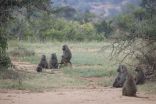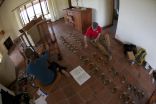Baboons decide where to go together
2015-06-18
(Press-News.org) This news release is available in Japanese.
Researchers have found evidence of shared decision-making among a troop of wild baboons, providing insight into how animals that live in socially complex, hierarchical societies reach consensus on decisions that affect the entire group. Until now, researchers had wondered if animals with clear hierarchies, such as primates or wolves, use democracy to reach a consensus -- or if their decisions are governed by dominant leaders. It's been difficult to study this, however, because recording the behavior of many individuals simultaneously has been a challenge, restricting studies of collective animal behavior to species with comparatively simpler social systems. Here, Ariana Strandburg-Peshkin and colleagues leveraged recent advances in global positioning system (GPS) technology to track the movements of baboons. They fitted 25 wild olive baboons at the Mpala Research Center in Kenya with custom-designed GPS collars and recorded the baboons' locations every second of the day, analyzing the animals' movements relative to one another. Their data identify certain baboons as initiators -- animals that start moving away from other baboons and either "pull" followers with them or "anchor" those individuals in place until the initiator wanders back. Strandburg-Peshkin and her team found that baboons are generally more likely to follow others when multiple individuals act as initiators and agree on a particular direction. However, when initiators' opinions are split over where to go, decisions get delayed, according to the researchers. Baboons typically don't attempt to negotiate, instead choosing one direction over the other, if the angle between the options is larger than 90 degrees, but the monkeys do attempt to compromise if two initiators suggest different directions with less than 90 degrees difference between them. These findings suggest that shared, democratic decision-making is widespread even among species with highly stratified social hierarchies. Understanding how groups that exist in such hierarchies reach consensus is critical to understanding the evolution of other socially complex species.
INFORMATION:
Article #15: "Shared decision-making drives collective movement in wild baboons," by A. Strandburg-Peshkin; I.D. Couzin at Princeton University in Princeton, NJ; D.R. Farine; M.C. Crofoot at University of California, Davis in Davis, CA; D.R. Farine; M.C. Crofoot at Smithsonian Tropical Research Institute in Balboa, Panama; D.R. Farine at University of Oxford in Oxford, UK; I.D. Couzin at Max Planck Institute for Ornithology in Konstanz, Germany; I.D. Couzin at University of Konstanz in Konstanz, Germany.
ELSE PRESS RELEASES FROM THIS DATE:
2015-06-18
This news release is available in Japanese. A new study aiming to provide a better understanding of how injection wells in the U.S. influence earthquake activity cites wastewater injection rate as a critical factor. In the study, the highest-rate wastewater disposal wells analyzed were nearly twice as likely to be associated with earthquake events compared to their lower-rate counterparts. Earthquakes can be induced by industrial processes, a fact established decades ago. Since 2009, when seismicity in the U.S. midcontinent began to surge, earthquakes induced by the underground ...
2015-06-18
This news release is available in Japanese. Opening Iran's national uranium enrichment plant to multinational involvement could limit the long-term risks of Iran's nuclear program as restrictions on it expire, according to this Policy Forum. In July, Iran is expected to sign an agreement restricting its nuclear program, but also affirming its right to pursue uranium enrichment as those restrictions end in 2025 and beyond. Authors Alexander Glaser, Zia Mian, and Frank von Hippel suggest that selling shares of Iran's uranium enrichment plant to other countries could help ...
2015-06-18
PRINCETON, N.J.--Within the next two weeks, or soon after, the United States and five world powers hope to finalize a nuclear deal with Iran to limit its nuclear activities in exchange for a relaxing of international economic and financial sanctions. But what happens in 10 years when some of the key restrictions being discussed begin to phase out?
One of the biggest concerns is Iran's uranium enrichment program, which uses high-speed centrifuges to produce uranium enriched to a level appropriate for nuclear power reactor fuel. Enrichment plants like this can be quickly ...
2015-06-18
Well-practiced motor skills like riding a bike are extremely stable memories that can be effortlessly recalled after years or decades. In contrast, a new study publishing in PLOS Computational Biology shows that changes to motor skill memories occurring over the course of a single practice session are not immediately stable, according to researchers Andrew Brennan and Maurice Smith of Harvard University School of Engineering and Applied Science and Center for Brain Science.
We're all familiar with the old saying that you never forget how to ride a bike and perhaps personally ...
2015-06-18
Chlamydia trachomatis is a formidable foe. It's the most common sexually transmitted pathogen, infecting more than 100 million people each year. In the developing world, chlamydial infection is the leading cause of preventable blindness. Around the world, it ranks as the number one cause of infertility and ectopic pregnancy.
Chlamydial infection ignites chronic inflammation, which scars mucosal surfaces such as eyelids, ovaries or fallopian tubes. Most people who carry the bacterium don't know it. Women with chlamydia are much more vulnerable to other sexually transmitted ...
2015-06-18
To predict how a seasonal influenza epidemic will spread across the United States, one should focus more on the mobility of people than on their geographic proximity, a new study suggests.
PLOS Pathogens published the analysis of transportation data and flu cases conducted by Emory University biologists. Their results mark the first time genetic patterns for the spread of flu have been detected at the scale of the continental United States.
"We found that the spread of a flu epidemic is somewhat predictable by looking at transportation data, especially ground commuter ...
2015-06-18
Baboons live in a strongly hierarchical society, but the big guys don't make all the decisions.
A new study from the University of California, Davis, reveals -- through GPS tracking -- that animals living in complex, stratified societies make some decisions democratically. The study breaks ground in how animal behavior data is collected.
The study is being published Friday (June 19) in Science.
"It's not necessarily the biggest alpha males that influence where groups go," said co-author Meg Crofoot, assistant professor of anthropology at UC Davis. "Our results illustrate ...
2015-06-18
DNA from the 8,500-year-old skeleton of an adult man found in 1996, in Washington, is more closely related to Native American populations than to any other population in the world, according to an international collaborative study conducted by scientists at the University of Copenhagen and the Stanford University School of Medicine.
The finding challenges a 2014 study that concluded, based on anatomical data, that Kennewick Man was more related to indigenous Japanese or Polynesian peoples than to Native Americans. The study is likely to reignite a long-standing legal ...
2015-06-18
NASA provided four different views of Tropical Depression Bill as it continued traveling through the south-central U.S. and into the Ohio Valley. NASA's Aqua and Terra satellite provided infrared and visible imagery while NASA/NOAA's GOES Project animated NOAA's GOES-East satellite imagery to show the storm's progression since landfall. The Global Precipitation Measurement or GPM core satellite also showed rainfall estimates and locations.
On June 18, the National Weather Service, Weather Prediction Center (NWS/WPC) noted that flood and flash flood watches and warnings ...
2015-06-18
Kangaroos prefer to use one of their hands over the other for everyday tasks in much the same way that humans do, with one notable difference: generally speaking, kangaroos are lefties. The finding, reported in the Cell Press journal Current Biology on June 18--the first to consider handedness in wild kangaroos--challenges the notion that "true" handedness among mammals is a feature unique to primates.
"According to a special-assessment scale of handedness adopted for primates, kangaroos pulled down the highest grades," says Yegor Malashichev of Saint Petersburg State ...
LAST 30 PRESS RELEASES:
[Press-News.org] Baboons decide where to go together




